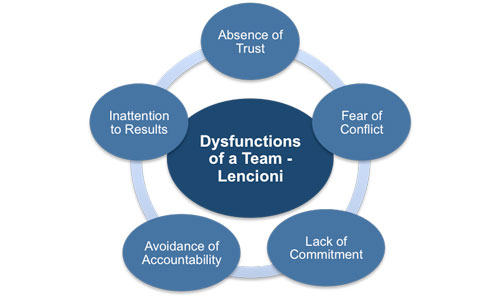Lencioni's Five Dysfunctions of a Team
Whenever a team is constructed to work toward a goal, there are going to be problems. That isn't so much a negative statement as it is an honest one. If you are a manager who works in a leadership position in your organization, you know this to be true. People working together toward a common goal is bound to lead to issues simply because every individual brings slightly different goals, aspirations, skills, and more to the table. While that is the great strength of a team - its diversity - it can also be its biggest weakness.
The 'Dysfunctions of a Team' book by Patrick Lencioni addresses some of the common problems that are found within teams. Anyone who has ever led a team, or even worked as part of a team, will likely be able to recognize each of these five problems. Simply by understanding that these issues could exist within your team, you will be better prepared to identify and correct them as quickly as possible.
 |
1) Absence of Trust
The first dysfunction on the list is simply having team members who are unwilling to trust each other, or you as a leader. The natural tendency for many people is to want to be as self-reliant as possible, mostly because this is their job and they want to control their own fate. Trusting a team member, or you as the leader, with part of their job feels risky because they could be seen in a bad light if things don't work out.
However, getting team members to trust each other is an important part of long-term success. It doesn't do much good to have assembled a team if that team is unwilling to support each and rely on each other to each tackle a small piece of the overall puzzle. Building trust is a challenge that every manager must face, but it is something that needs to be done in order to foster a successful and healthy team environment.
2) Fear of Conflict
Many people view conflict as always being a bad thing, when that isn't necessarily the case. While too much conflict is certainly bad within a team, a healthy amount of debate and discussion can lead to the best possible outcomes. Great ideas are often borne from two or more people standing firm on their ideas and opinions and trying to convince others to see it their way. When this happens, new ideas can emerge that might be better than any one individual had thought of previously.
 |
That healthy debate is often lost within a team that would rather pretend that they all agree for the sake of avoiding conflict and keeping everything friendly between team members. It is your job as manager to develop a culture that makes people comfortable with the idea of minor conflict in the name of learning and innovating. Striking a balance between healthy conflict and constant bickering is something that a good leader will need to do.
3) Lack of Commitment
Members of a team, no matter what the goal or task, need to be fully committed to the task at hand. Too often, people working within an organization don't really want to be part of the team they have been assigned to, so they end up faking their interest and concern for the team as a whole. Success is never going to be truly achieved when certain members of a team just aren't interested in giving their full effort to a project.
The solution to this problem is making sure that each member of the team understands how important their role is, and how important the project is as a whole. Most people naturally are going to be first concerned with what this means for them and their career, so identifying ways that each individual can personally benefit from the success of the team is a great way to improve 'buy-in' among the group.
4) Avoidance of Accountability
Within a team, there should be mutual accountability that helps to keep everyone moving forward toward a common goal. Not only should team members be accountable to the leader of the group, they should also feel like they are accountable to each other and themselves. This again comes back to ownership of the project and 'buying-in' to the process as a whole.
Standards should be high for any project that your team is engaged in. However, when no one is being held accountable properly for the work they are doing (or not doing), it puts everyone on a path toward poor performance and sub-standard work. Healthy teams will be able to hold each other accountable throughout the process and may not even need much from the leader in terms of motivation or management because they are successfully handling those functions among themselves.
5) Inattention to Results
The main objective should always be team success, not personal gain for either financial or ego purposes. While personal benefits can often be realized from being part of a successful team, the focus should start and remain on meeting the goals of the team first, with personal aspirations put on the back burner. When a team is made up of a group of individuals who are only focused on making sure that their individual needs and goals are met, the overall picture of the team is not likely to be a successful one.
These five 'Dysfunctions of a Team' are a great picture of what can go wrong within a team that has been built to work toward a specific goal. Any good manager will be able to watch out for signs of these problems so they can be mitigated as quickly and successfully as possible. While it might not be realistic to try and avoid any of these issues altogether for the complete term of a project, maintaining a healthy team atmosphere as much as possible is desired. Teams that are able to mostly stay away from these five dysfunctions are ones that should be on a direct path for optimal performance.
You may also be interested in:
Mintzberg's Management Roles | Lencioni's Five Dysfunctions of a Team | Birkinshaw's Four Dimensions of Management | Waldroop and Butler's Six Problem Behaviors | Cog's Ladder | Leader-Member Exchange Theory | Belbin's Team Roles | Benne and Sheats' Group Roles | Margerison-McCann Team Management Profile | The JD-R Model.



